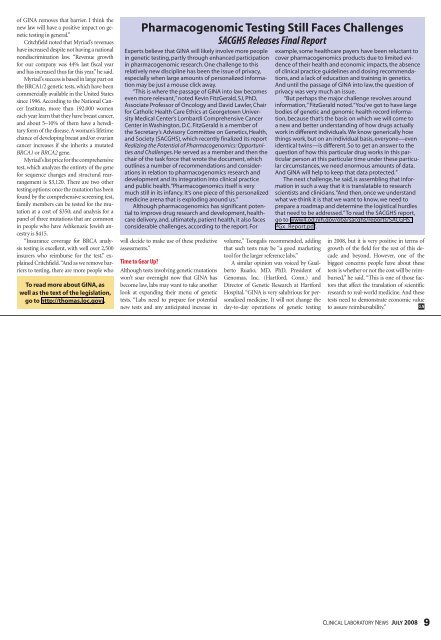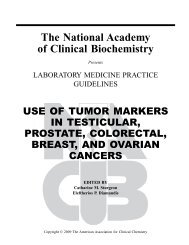Clinical Laboratory News - American Association for Clinical ...
Clinical Laboratory News - American Association for Clinical ...
Clinical Laboratory News - American Association for Clinical ...
You also want an ePaper? Increase the reach of your titles
YUMPU automatically turns print PDFs into web optimized ePapers that Google loves.
of GINA removes that barrier. I think the<br />
new law will have a positive impact on genetic<br />
testing in general.”<br />
Critchfield noted that Myriad’s revenues<br />
have increased despite not having a national<br />
nondiscrimination law. “Revenue growth<br />
<strong>for</strong> our company was 44% last fiscal year<br />
and has increased thus far this year,” he said.<br />
Myriad’s success is based in large part on<br />
the BRCA1/2 genetic tests, which have been<br />
commercially available in the United States<br />
since 1996. According to the National Cancer<br />
Institute, more than 192,000 women<br />
each year learn that they have breast cancer,<br />
and about 5–10% of them have a hereditary<br />
<strong>for</strong>m of the disease. A woman’s lifetime<br />
chance of developing breast and/or ovarian<br />
cancer increases if she inherits a mutated<br />
BRCA1 or BRCA2 gene.<br />
Myriad’s list price <strong>for</strong> the comprehensive<br />
test, which analyzes the entirety of the gene<br />
<strong>for</strong> sequence changes and structural rearrangement<br />
is $3,120. There are two other<br />
testing options: once the mutation has been<br />
found by the comprehensive screening test,<br />
family members can be tested <strong>for</strong> the mutation<br />
at a cost of $350; and analysis <strong>for</strong> a<br />
panel of three mutations that are common<br />
in people who have Ashkenazic Jewish ancestry<br />
is $415.<br />
“Insurance coverage <strong>for</strong> BRCA analysis<br />
testing is excellent, with well over 2,500<br />
insurers who reimburse <strong>for</strong> the test,” explained<br />
Critchfield. “And as we remove barriers<br />
to testing, there are more people who<br />
To read more about Gina, as<br />
well as the text of the legislation,<br />
go to http://thomas.loc.gov/.<br />
pharmacogenomic Testing still faces challenges<br />
SACGHS Releases Final Report<br />
experts believe that gina will likely involve more people<br />
in genetic testing, partly through enhanced participation<br />
in pharmacogenomic research. one challenge to this<br />
relatively new discipline has been the issue of privacy,<br />
especially when large amounts of personalized in<strong>for</strong>mation<br />
may be just a mouse click away.<br />
“this is where the passage of gina into law becomes<br />
even more relevant,” noted Kevin fitzgerald, sJ, phd,<br />
associate professor of oncology and david lawler, Chair<br />
<strong>for</strong> Catholic Health Care ethics at georgetown university<br />
Medical Center’s lombardi Comprehensive Cancer<br />
Center in washington, d.C. fitzgerald is a member of<br />
the secretary’s advisory Committee on genetics, Health,<br />
and society (saCgHs), which recently finalized its report<br />
Realizing the Potential of Pharmacogenomics: Opportunities<br />
and Challenges. He served as a member and then the<br />
chair of the task <strong>for</strong>ce that wrote the document, which<br />
outlines a number of recommendations and considerations<br />
in relation to pharmacogenomics research and<br />
development and its integration into clinical practice<br />
and public health. “pharmacogenomics itself is very<br />
much still in its infancy. it’s one piece of this personalized<br />
medicine arena that is exploding around us.”<br />
although pharmacogenomics has significant potential<br />
to improve drug research and development, healthcare<br />
delivery, and, ultimately, patient health, it also faces<br />
considerable challenges, according to the report. <strong>for</strong><br />
will decide to make use of these predictive<br />
assessments.”<br />
Time to Gear Up?<br />
Although tests involving genetic mutations<br />
won’t soar overnight now that GINA has<br />
become law, labs may want to take another<br />
look at expanding their menu of genetic<br />
tests. “Labs need to prepare <strong>for</strong> potential<br />
new tests and any anticipated increase in<br />
volume,” Tsongalis recommended, adding<br />
that such tests may be “a good marketing<br />
tool <strong>for</strong> the larger reference labs.”<br />
A similar opinion was voiced by Gualberto<br />
Ruaño, MD, PhD, President of<br />
Genomas, Inc. (Hart<strong>for</strong>d, Conn.) and<br />
Director of Genetic Research at Hart<strong>for</strong>d<br />
Hospital. “GINA is very salubrious <strong>for</strong> personalized<br />
medicine. It will not change the<br />
day-to-day operations of genetic testing<br />
example, some healthcare payers have been reluctant to<br />
cover pharmacogenomics products due to limited evidence<br />
of their health and economic impacts, the absence<br />
of clinical practice guidelines and dosing recommendations,<br />
and a lack of education and training in genetics.<br />
and until the passage of gina into law, the question of<br />
privacy was very much an issue.<br />
“but perhaps the major challenge revolves around<br />
in<strong>for</strong>mation,” fitzgerald noted. “You’ve got to have large<br />
bodies of genetic and genomic health record in<strong>for</strong>mation,<br />
because that’s the basis on which we will come to<br />
a new and better understanding of how drugs actually<br />
work in different individuals. we know generically how<br />
things work, but on an individual basis, everyone—even<br />
identical twins—is different. so to get an answer to the<br />
question of how this particular drug works in this particular<br />
person at this particular time under these particular<br />
circumstances, we need enormous amounts of data.<br />
and gina will help to keep that data protected.”<br />
the next challenge, he said, is assembling that in<strong>for</strong>mation<br />
in such a way that it is translatable to research<br />
scientists and clinicians. “and then, once we understand<br />
what we think it is that we want to know, we need to<br />
prepare a roadmap and determine the logistical hurdles<br />
that need to be addressed.” to read the saCgHs report,<br />
go to www4.od.nih.gov/oba/sacghs/reports/saCgHs_<br />
pgx_report.pdf.<br />
in 2008, but it is very positive in terms of<br />
growth of the field <strong>for</strong> the rest of this decade<br />
and beyond. However, one of the<br />
biggest concerns people have about these<br />
tests is whether or not the cost will be reimbursed,”<br />
he said. “This is one of those factors<br />
that affect the translation of scientific<br />
research to real-world medicine. And these<br />
tests need to demonstrate economic value<br />
to assure reimbursability.” CLN<br />
CliniCal laboratory news JuLy 2008 9
















